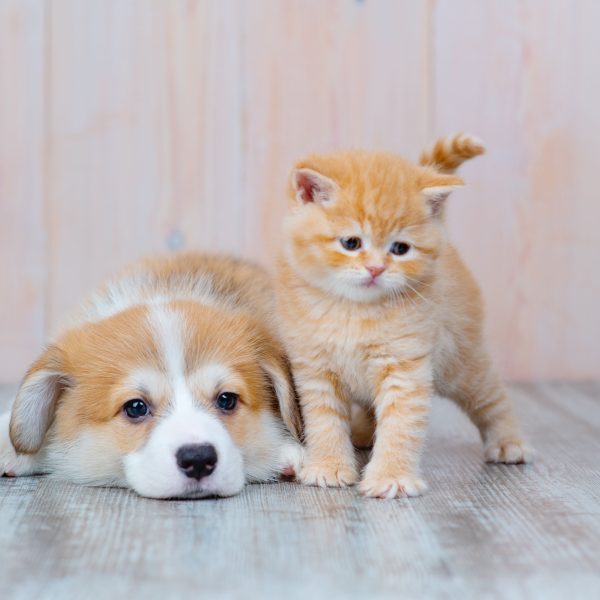How to Stop Dog Aggression Towards Cats

It’s a common trope in stories that dogs love to chase cats, but there is some truth to it. While some dogs might chase cats for fun, some dogs may unintentionally cross over into aggression that might cause harm to the cat. Here’s what to know and how to stop dog aggression towards cats:
Why Do Dogs Chase Cats?
There are a few reasons why dogs chase cats, but a lot of it boils down to a natural instinct. Almost all dogs have a prey drive to some degree, with some breeds having a higher prey drive than others, such as Australian Shepherds or Terriers.
This prey drive in a dog is often triggered by movement and cats are nimble and quick. This sudden darting away almost always triggers that instinct in a dog. It may also be a territorial instinct for your dog to protect you and their surroundings from a cat.
However, just because a dog chases a cat doesn’t necessarily mean they want to harm them. Some dogs love to chase just for fun. Other dogs may have a much higher prey drive that can result in a little bit more aggressive behavior toward their target. These breeds may be harder to train out of that tendency. But, it’s not a lost cause; there are ways to help manage prey drive in dogs, like redirecting it into specific activities.
How To Stop Dog Aggression Towards Cats
If you notice your dog exhibiting any aggression towards your cats, there are a few things you can do to help these two furry friends get along:
1. Figure Out Why Your Dog is Aggressive Towards Cats
You may need to work with a trainer to identify the driving force behind your dog’s behavior. Once that reason is identified, you can start working on ways to train your dog to behave better around cats. There are a few reasons dogs may exhibit some aggression towards cats which can include fear, resource guarding, a high prey drive, or the frustration of wanting to play.
For example, if your dog is chasing your cat because they want to play, you might be able to distract them with toys, more consistent exercise, or more intense playtime. A well-exercised dog is usually too tired to chase a cat.
But, if your dog is showing some aggression toward your cat, it might be because they’re scared of the cat. If this is the case, you may need to work on some socialization and desensitization as well as some obedience cues.
2. Have Safety Zones For Each Animal
Sometimes, your cat and dog just need to be in different areas for a while. Each pet deserves the freedom to roam the house without a threat from the other animal. Baby gates are a great tool to use and can help mitigate any negative interactions between the two. They’re also a great tool for training a puppy or handling a dog around people with a fear of dogs.
Cat trees or platforms that your dog can’t reach are also great tools. Cats love to be above everyone else and observe their surroundings. Your dog can still see the cat and will, hopefully, adjust to their presence without being too close.
Try to schedule times when each pet can roam freely. This may mean keeping your cat in one area while your dog has the rest of the house to explore. You can also put your dog in a crate for a little bit while your cat has free reign.
3. Don’t Force the Process
It can be extremely frustrating to have a dog that is aggressive towards your cat. However, you cannot force the process and expect immediate results. It will take time and patience for these two very different animals to learn how to cohabitate happily, or at least civilly.
You’re going to have to start slow. If your dog and cat have been living together for a while but your dog still shows signs of aggression, make sure each animal has their own safety zones. Don’t force your dog to be around the cat, especially if they’re scared. This can make them not trust you, which can be harmful to your relationship with your dog.
4. Use Plenty of Positive Reinforcement
Positive reinforcement is a popular dog training method because it works. When a dog associates something good with a behavior or an activity, they’re more likely to do it. If your dog starts to associate your cat with good things, they may begin to feel less stressed around cats.
Pick a time when your dog is relaxed to spend some time around the cat. Make sure you have your dog close by your side, preferably on a leash. Simply being in the same room is a good way to get some exposure therapy. Offer your dog a treat as soon as they see the cat. Not only will this distract them momentarily, but they’ll also learn that when the cat appears, so does a treat.
If your dog can remain calm and relaxed around the cat, offer treats as well as praise. Make sure you watch for dog body language clues that signal stress or anxiety. Keep these times together brief at first so neither animal gets too stressed out. As your dog adjusts to your cat, you can extend the length of time.
This is an overview of how to stop dog aggression towards cats. Some dog breeds get along well with cats, some need extra socialization and training to be able to share space, and some just will never be fans of felines. While some dogs may never truly become best friends with your cat, cohabitation can be possible with proper training, positive reinforcement, and patience!
